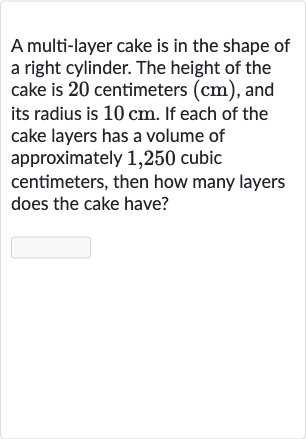Full solution
Q. A multi-layer cake is in the shape of a right cylinder. The height of the cake is centimeters , and its radius is . If each of the cake layers has a volume of approximately , cubic centimeters, then how many layers does the cake have?
- Identify Formula and Values: Identify the formula for the volume of a cylinder and the given values.Volume of a cylinder = Given: radius = , height of each layer = , volume of each layer =
- Calculate Cake Volume: Calculate the volume of the entire cake using the formula for the volume of a cylinder.Volume of the entire cake = Volume of the entire cake = Volume of the entire cake =
- Find Number of Layers: Divide the total volume of the cake by the volume of one layer to find the number of layers.Number of layers Number of layers
- Perform Division: Perform the division to find the number of layers.Number of layers Number of layers Since is approximately , we can approximate the number of layers.Number of layers Number of layers
- Round to Nearest Whole Number: Since the number of layers must be a whole number, round the result to the nearest whole number.Number of layers
More problems from Pythagorean theorem
QuestionGet tutor help
QuestionGet tutor help
QuestionGet tutor help
QuestionGet tutor help
QuestionGet tutor help
QuestionGet tutor help
QuestionGet tutor help
QuestionGet tutor help
QuestionGet tutor help

